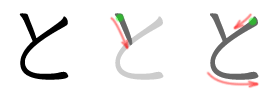
Kaoko: Konnichiwa, minna! How are you doing today? I hope you are all in your high spirits and ready for the course.
Today's lesson is the for the final T Section's character, 'と'! と, in hiragana, or ト in katakana, is one of the Japanese kana, each of which represents one mora. Both represent the sound [to], and when written with dakuten represent the sound [do]. Ah, I forgot! We also have a guest today... Our character for today’s lesson is...!!
*Oink, oink...*
Kaoko: Eh? *Turns to look* TONTON
 !!??
!!??Pronunciation:
'と' is romanized 'to'.
Words with 'と':
'と' at the beginning:
- 友達/ともだち (tomodachi -> friend)
- 時/とき (toki -> time)
- 時計/とけい (tokei -> watch, clock)
- 取る/とる (toru -> to take, to obtain)
- 所/ところ (tokoro -> a place, a scene, a site; an address)
- と言う/という (to iu -> said, called thus)
- 止まる/とまる (tomaru -> to stop)
- 迚も/とっても (tottemo -> very, exceedingly, awfully)
'と' in the middle:
- 勤める/つとめる (tsutomeru -> to work; to be employed)
- それとも (soretomo -> or, or else)
- 例え/たとえ (tatoe -> an example, a simile, a metaphor)
- 例えば/たとえば (tatoeba -> for example, for instance, such as)
- 中東/ちゅうとう (chuutou -> Middle East)
'と' at the end:
- 外/そと (soto -> outside)
- そっと (sotto -> softly, gently)
- 旅人/たびびと (tabibito -> traveler)
- もっと (motto -> more; even more; longer; further)
Stroke order:


______________
The character 'と' may also be combined with a dakuten, changing it into ‘ど’ in hiragana. With the dakuten added the pronunciation changes to 'do'. と + " (dakuten) = と (look below)

Pronunciation:
‘ど’ is romanized ‘do’, and pronounced ‘do’ as in ‘door’.
Words with 'ど':
'ど' at the beginning:
- どこ (doko -> where)
- どうぞ (douzo -> please (go ahead); help yourself; certainly you may)
- 毒/どく (doku -> poison)
'と' in the middle:
- 留まる/とどまる (todomaru -> to stay)
- 鉄道/てつどう (testudou -> railway)
'と' at the end:
- のど (nodo -> throat)
- 粘土/ねんど (nendo -> clay)
Task: You shall write 'と' & 'ど' 50 - 100 times in your textbook. If you want, like with the previous lessons, write 'と' 70 times and 'ど' 30 times. Memorize the shape, the stroke order, the sound, the pronunciation (echo the sound of the character each time you write it down), etc.
After you finish with that, write 'た', 'ち', ‘つ’, ‘て’, and 'と' one after each repetitively (た, ち, つ, て, と, た, ち, つ, て, と, etc.) 50 times (100 if you have time).
Finish! We finished the T Group! Let’s move on to the N's Group!
Tonton: Oink...


No comments:
Post a Comment